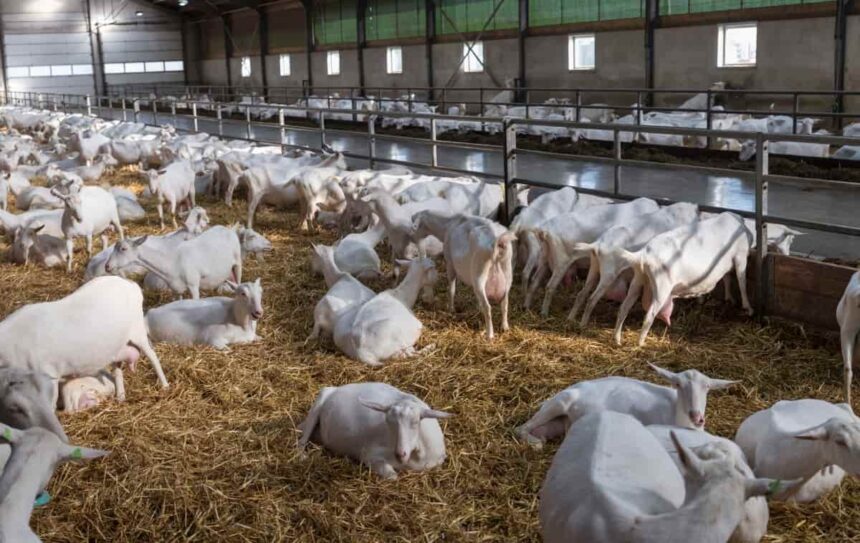Building a low-budget goat shed requires a strategic approach that balances cost-effectiveness with the goats’ essential needs. In this guide, we will explore various cost-saving strategies and practical tips for designing and constructing a functional goat shelter without breaking the bank. From understanding basic goat shelter needs to low-cost maintenance strategies, we’ll cover every aspect of budget-friendly goat shed construction.
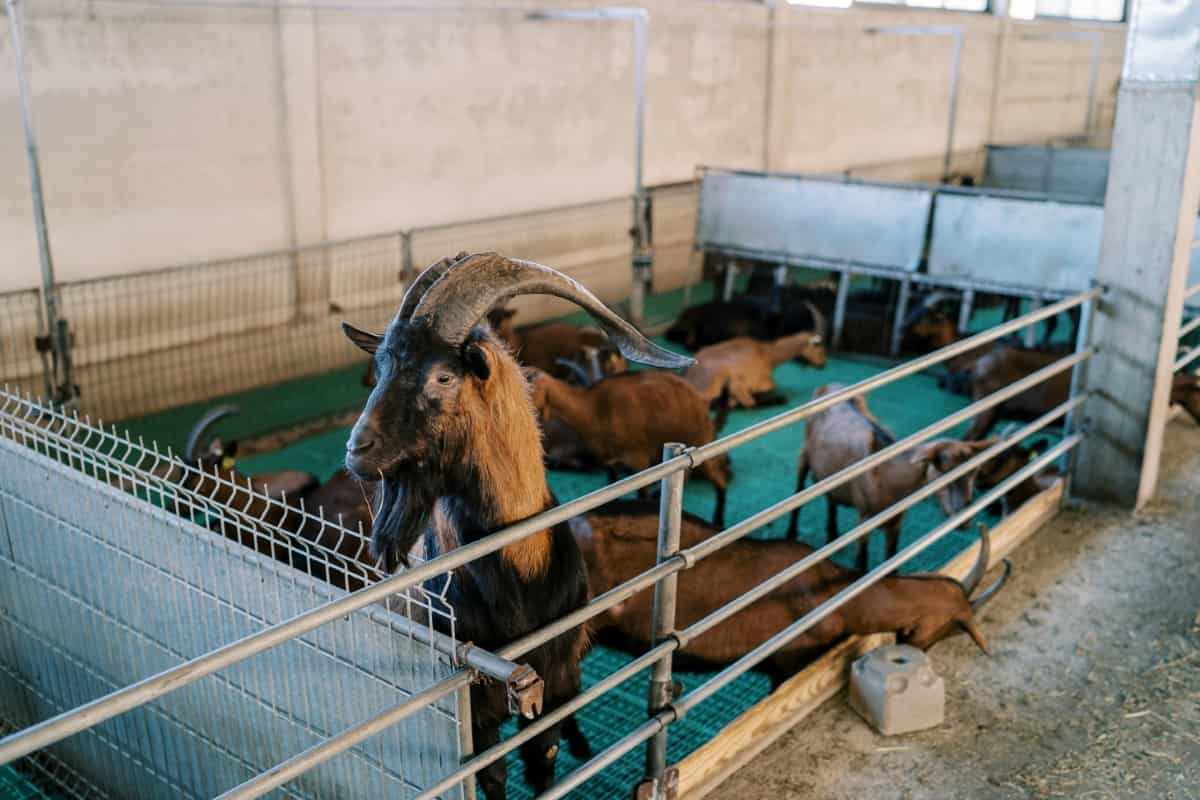
Understanding Basic Goat Shelter Needs
Goat shelters are essential for protecting the herd from weather extremes. A low-budget option is a three-sided shed made from repurposed wood pallets, providing adequate space, ventilation, and protection from wind and rain. For instance, one could construct the shelter by stacking pallets to form walls and covering the top with corrugated metal or tarp for durability. This simple structure meets the basic needs of goats for a dry, clean, and safe living environment while also being cost-effective and flexible for future modifications or relocations.
Maximizing Your Budget
Maximizing your budget for a low-cost goat shed can be achieved by utilizing affordable materials like wooden pallets. Pallets often be acquired for free or at a minimal cost and are sturdy enough to construct a functional shelter. By stacking the pallets to form walls and covering the structure with corrugated metal or plastic sheets for the roof, you can create a durable shelter that protects your goats from the elements. This approach not only saves money but also allows for flexibility in design, ensuring that the shelter can be adapted or expanded as needed.
Selecting an Affordable Location
Selecting an affordable location for a low-budget goat shed involves considering factors like climate, topography, and accessibility. For example, a farmer in a temperate region might utilize a south-facing slope to maximize sunlight exposure and natural wind protection. They could construct the shed using locally sourced materials such as wood or repurposed pallets, keeping costs low. Additionally, positioning the shed near a natural water source can reduce the need for expensive plumbing.
Simplifying Shed Designs
A simple and cost-effective goat shed can be constructed using wooden pallets, which are often available for free or at a low cost. The design involves creating a three-sided structure that provides shelter from the elements. The open side allows for ventilation and easy access for the goats.
In case you missed it: Goat Farming Training Programs in India: A Beginner’s Guide
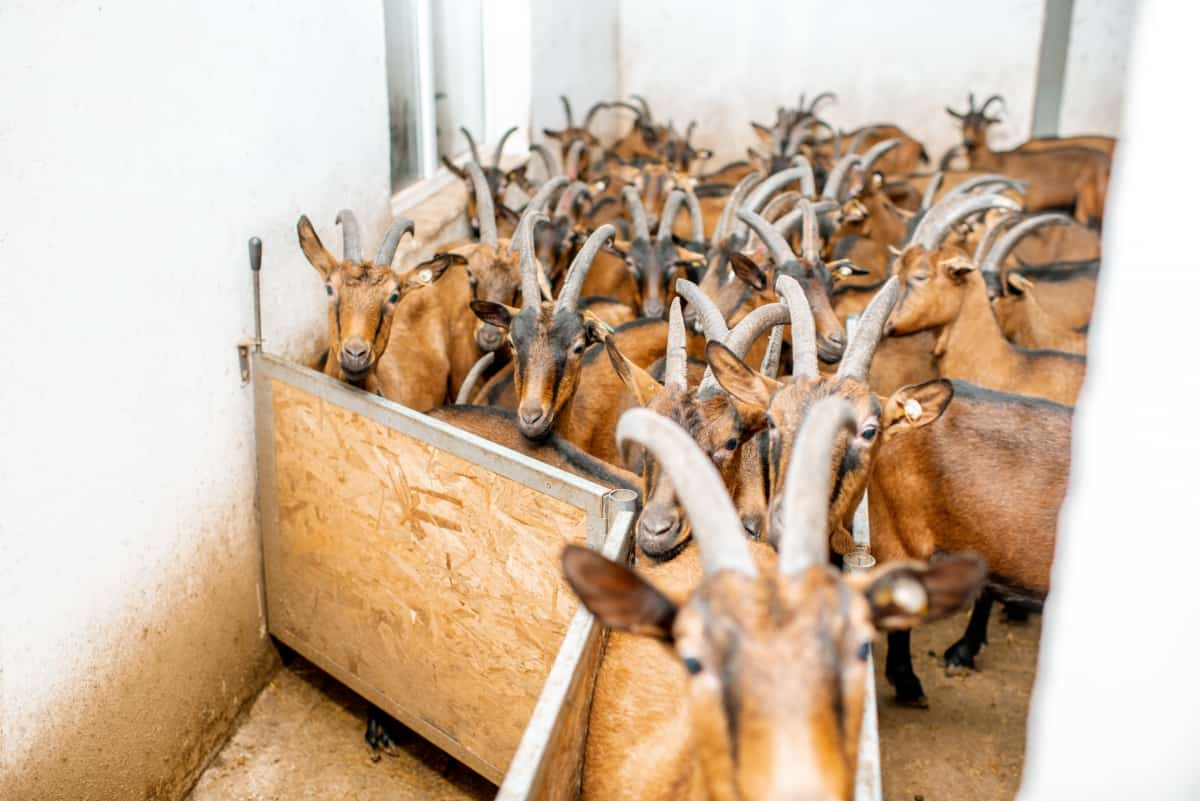
The pallets can be reinforced with additional planks for stability and covered with a tarp or corrugated metal for roofing. This type of shed is not only economical but also flexible, as it can be easy modified to accommodate changes.
Sourcing Low-Cost Materials
For example, using locally sourced lumber, gravel, and stone can reduce transportation costs and support the local economy. Additionally, researching bulk purchase options for building materials can often lead to significant cost savings. For a cost-effective goat shed, sourcing materials such as pallets can be economical. Pallets are often available for free or at a low cost from local businesses. They can be assembled to structure, creating walls and partitions. For roofing, corrugated metal sheets or plastic can protect from the elements at a minimal expense.
Utilizing Recycled Building Supplies
Recycled building materials can be a cost-effective and eco-friendly option for constructing goat sheds. For instance, wooden pallets, often available for free or at a low cost, can be repurposed to create the framework of a shed. By stacking and securing the pallets, one can form the walls and even the flooring of the structure. A durable roof can be fashioned from corrugated metal sheets or plastic, protecting it from the elements. This approach not only saves money but also contributes to reducing waste, making it a sustainable choice for small-scale farmers or homesteaders.
DIY Tools and Resources
Creating a goat shed is a practical project that can be accomplished with basic DIY tools and resources. For instance, you might need wooden posts like 4x4s for the frame, plywood or OSB sheets for walls and the roof, 2x4s for frame support and rafters, and roofing materials such as corrugated metal or shingles. Essential tools include a hammer, saw, drill, and measuring tape.
One can find free DIY goat shelter plans online that provide comprehensive steps to construct a weather and predator-safe house for your goats. These plans often allow for customization, enabling you to tailor the shelter to your goats’ specific needs and the conditions of your property. Using recycled materials like pallets can save money and add a personal touch to the shelter.
Groundwork and Foundation Tips
When constructing a goat shed, it is crucial to select a location with good drainage, preferably on high ground. For the foundation, cinder blocks or concrete piers can provide a sturdy base that keeps the structure off the ground, preventing moisture problems and extending the shed’s lifespan. The size of the shed should accommodate the movement and grazing needs of the goats.
Inside, the flooring should be considered carefully; while concrete is durable, it can be expensive and cold for the goats. Alternatively, dirt floors are inexpensive but can lead to issues with dampness and parasites. A middle-ground option is using crushed gravel, which offers proper drainage and is cost-effective.
In case you missed it: Top 20 Goat and Sheep Weight Gain Supplements: Best Sheep and Goat Weight Gain Formulas
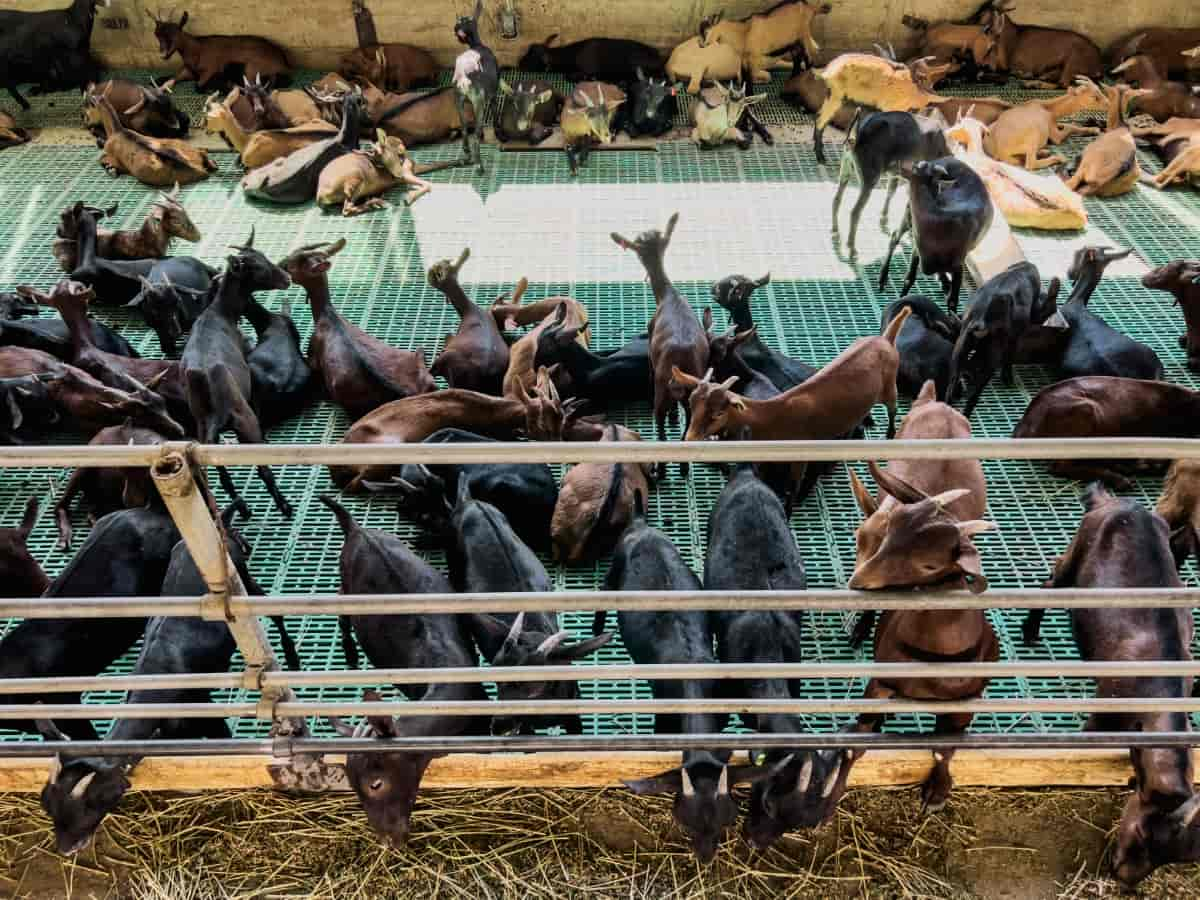
The walls can be constructed from wood or metal, depending on budget and preference, but should include some form of insulation to protect against extreme temperatures. For roofing, materials like metal sheets can provide excellent protection from the elements. Ventilation is also key; windows or vents that can be opened and closed will help regulate airflow and temperature, ensuring a comfortable environment for the goats throughout the year.
Economical Framing Techniques
Using recycled pallets as the primary material for the frame is a cost-effective and environmentally friendly option. Pallets can often be obtained for free or at a low cost from local businesses. They are sturdy enough to provide a solid structure and can be easily assembled with screws for added stability. The roof can be constructed from corrugated metal sheets, which are durable and provide excellent protection from the elements.
Plywood or corrugated steel sheets are affordable and effective for the sides of the shed. Proper ventilation is essential, so incorporating windows or vents that can be opened or closed as needed is a smart design choice. This allows for airflow regulation, which is crucial for the goats’ health. Additionally, a simple dirt floor can be used, but to avoid drainage issues, a layer of crushed gravel can be added, which is both economical and effective in managing waste and moisture.
Cost-Effective Roofing Solutions
Cost-effective roofing solutions for a goat shed can significantly reduce the overall expenses of setting up and maintaining a goat farm. One practical approach is utilizing recycled materials, such as wooden pallets for the frame, which are often available at a low cost or even free. For the roofing, corrugated metal sheets or shingles can be used, depending on budget constraints and availability.
These materials are durable, provide excellent protection from the elements, and require minimal maintenance. In regions with mild weather, thatched roofs can be a viable option, offering sufficient protection at a lower cost. Additionally, incorporating features like adjustable vents or movable panels can enhance the flexibility of the structure, allowing for better airflow and temperature control, which is crucial for the health and comfort of the goats.
Inexpensive Flooring Options
- Straw and Dirt: A traditional method where straw is spread over dirt. It’s affordable and provides insulation during colder months. However, it requires regular maintenance to prevent compacting and parasites.
- Concrete: Durable and easy to clean, concrete floors can be covered with rubber mats for added comfort. While initial costs may be higher, they offer long-term savings due to low maintenance.
- Crushed Gravel: This provides excellent drainage and is less expensive than concrete. It’s also easier to install and can be a good middle-ground option between dirt and concrete floors.
- Wood Chips or Sawdust: These can be used on top of dirt or gravel to provide a soft bedding that is easy to replace and compostable. However, they may need frequent replacement to maintain cleanliness.
- Interlocking Rubber Mats: These can be placed over any flat surface, offering a comfortable and easily cleanable floor. They are particularly useful over concrete to provide warmth and cushioning.
In case you missed it: Protecting Your Flock: A Comprehensive Guide to Vaccination Schedule for Goats and Sheep
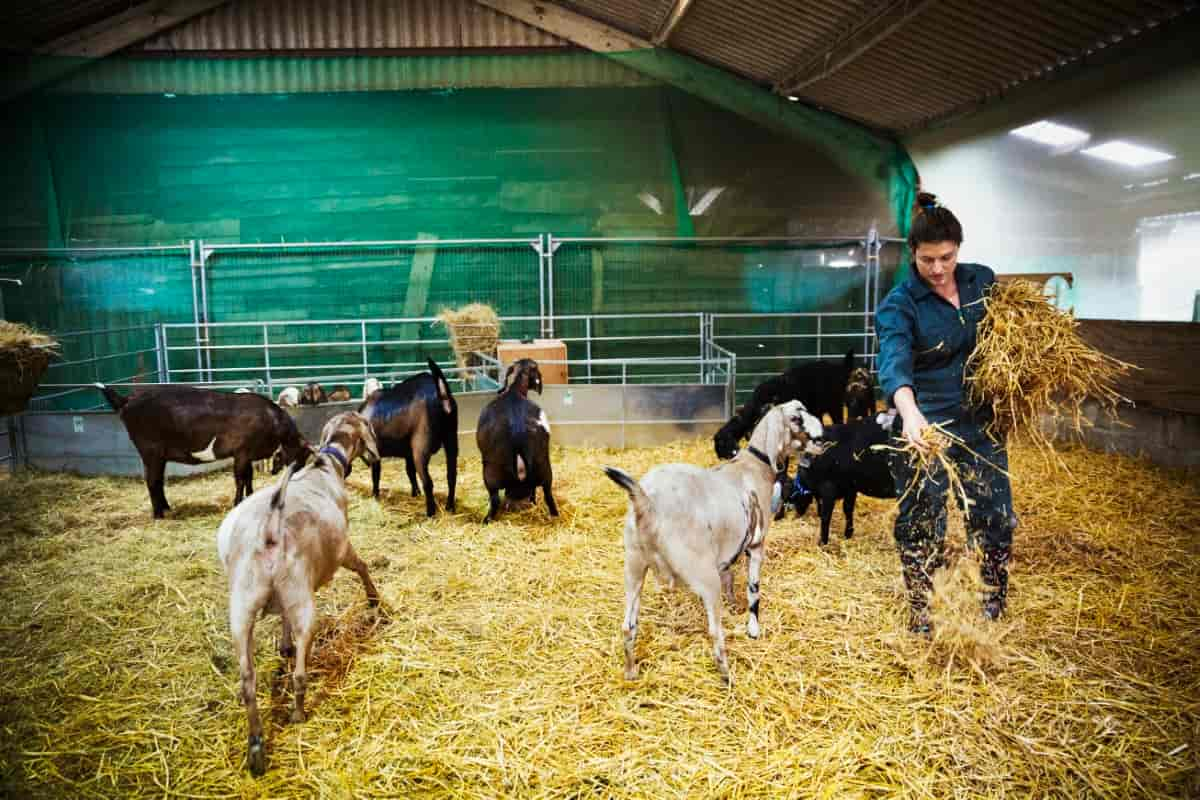
Building Functional Doors and Windows
Building functional doors and windows for a goat shed is crucial for ensuring the comfort and safety of the goats. DIY goat barn with sliding doors, windows can be constructed using 4×4 posts, 2×4 and 2×6 boards for the frame, roof plywood, and siding for the exterior. The doors can be made with 3ft pool fencing, hinges, c-channels, metal roofing, and equipped with door locks and handles for security.
Windows should be designed to provide adequate ventilation and light and keep the goats safe from predators and harsh weather. Plexiglass is a good material for windows as it’s durable and less likely to break, ensuring the goats’ safety. It’s also advisable to install wire mesh or hardware cloth on windows to prevent unwanted entry. The doors should be sturdy and capable of being securely locked at night to protect the goats from predators.
Interior Layout for Less Congestion
A well-planned layout should provide ample space for each goat to move freely, reducing stress and the potential for injury. A shed measuring 40 square meters can comfortably accommodate about 20 goats, allowing each goat approximately 2 square meters of space. The shed should be high enough to ensure proper ventilation, with a recommended height of 3 meters at the periphery and 3.5 meters at the center.
Openings for ventilation are essential to maintain a temperature of 28 to 30°C, as goats eat less and produce less in temperatures above 30°C. The orientation of the shed should also be considered; in dry regions, an east-west axis prevents excessive sunlight and heat, while in humid areas, a north-south axis allows sunlight to keep the shed dry. Additionally, the paddock area should be double the size of the shed to provide sufficient exercise space.
Protective Exterior Add-Ons
A simple yet effective add-on could be the installation of sturdy metal siding. This not only provides a shield against wind and rain but also deters predators and prevents goats from wandering off. Another example is a slanted roof made from corrugated panels, which ensures rainwater runoff and reduces moisture inside the shed, keeping the goats dry and comfortable. Additionally, using wire mesh for windows can offer ventilation while keeping the goats secure inside.
In case you missed it: Key Rules to Start Jamunapari Goat Farming: Requirements and Business Plan
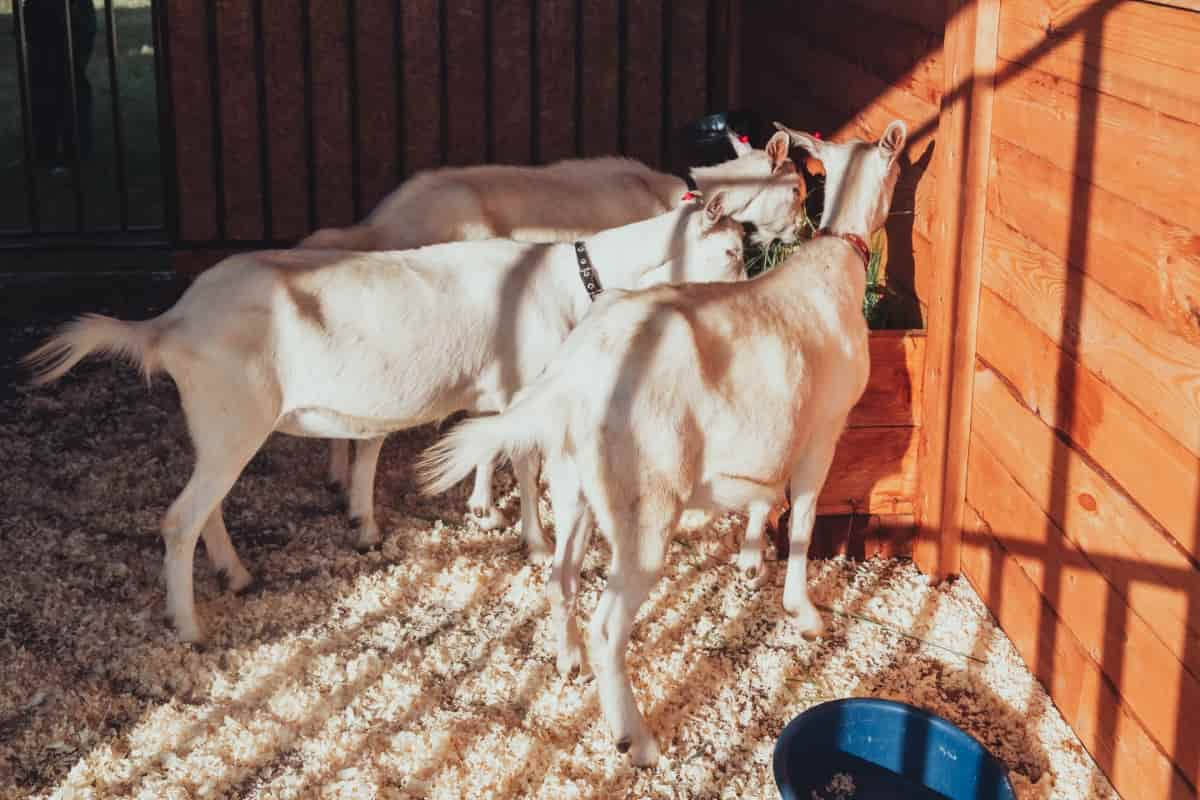
For regions with extreme weather, adding a thick layer of insulation under the roof can help maintain a stable temperature within the shed. Lastly, a tarp over the wire mesh windows can be rolled down during storms to provide extra protection. These add-ons are not only functional but can be constructed using affordable materials like wood pallets, metal sheets, and tarps, making them accessible for goat keepers to implement.
Applying Finishing Touches Economically
Using local materials such as bamboo and thatch can provide a cost-effective solution for roofing and wall construction. Additionally, ensuring proper ventilation can be achieved through strategic placement of windows and vents, which is crucial for the health of the goats and does not require expensive materials.
Simple measures like applying lime wash, which acts as a disinfectant, can maintain hygiene without incurring high costs. Moreover, incorporating raised wooden platforms can provide a comfortable resting area for the goats and help to keep them dry, especially during the rainy season. These platforms can be constructed from scrap wood or pallets, which are often available at a minimal expense.
Low-Cost Maintenance Strategies
Low-cost maintenance strategies for a goat shed focus on utilizing affordable and durable materials, along with design considerations that ensure ease of use and longevity. For example, Locally materials such as bamboo or recycled wood can significantly reduce costs. A simple yet effective design is a three-sided shed that provides shelter from the elements while allowing for proper ventilation.
The roof can be constructed from reclaimed metal sheets, which are cost-effective and provide excellent protection from rain and sun. Instead of concrete, one could use compacted earth or gravel for flooring, which is inexpensive and offers good drainage, reducing the risk of hoof problems. The farmer can do regular maintenance like cleaning and minor repairs, saving on labor costs. Implementing a rotational grazing system helps maintain the shed’s surroundings, as it prevents overgrazing and reduces the need for expensive feed supplements.
In case you missed it: Key Rules to Start Sirohi Goat Farming: Requirements and Business Plan
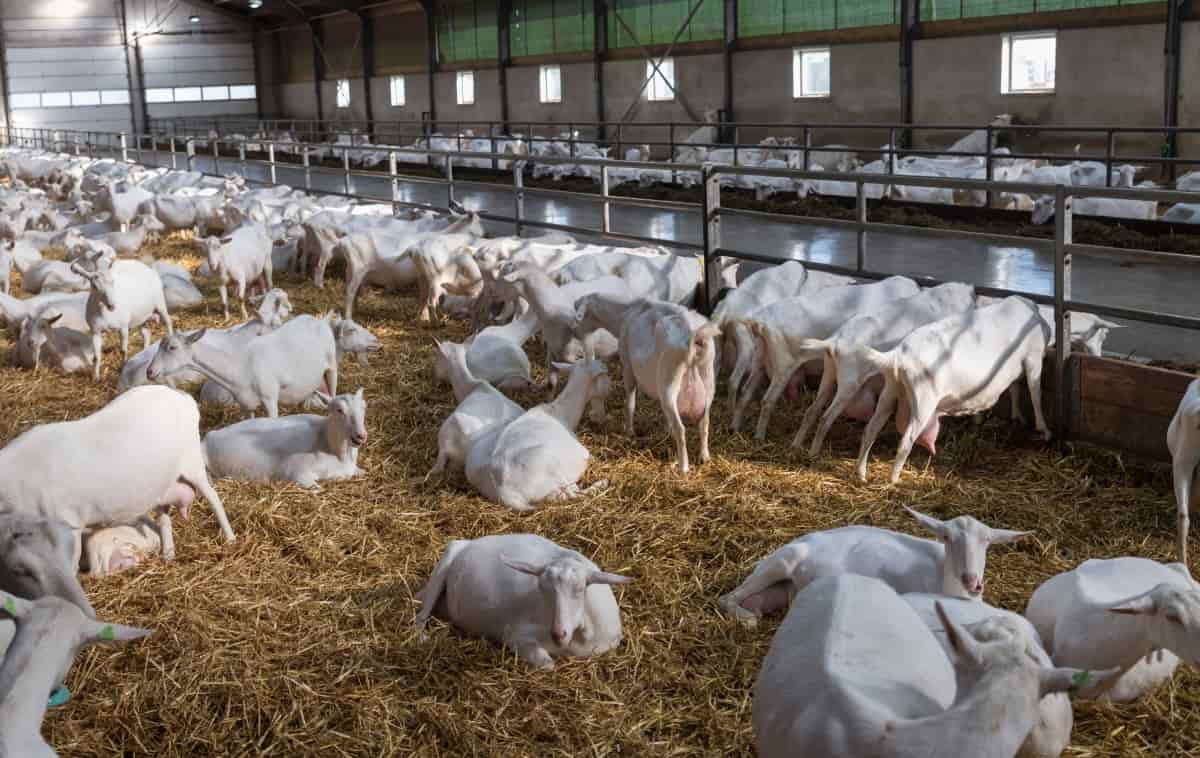
Building a low-budget goat shed requires strategic planning and resourcefulness. By utilizing cost-effective materials, such as PVC panels and reclaimed lumber, farmers can construct sturdy and economical shelters for their goats. Proper ventilation, maintenance, and insulation are essential for ensuring the goats’ well-being while minimizing construction costs.
- Ultimate Guide to Natural Vegetable Farming
- Natural Farming for Sustainable Livestock Management
- Dairy Farm Technology in India: The Future of Dairy Husbandry
- Comprehensive Guide to Organic Farming in Villages
- Modern Sheep Farming Technology: The Future of Sheep Husbandry
- Goat Farming Technology: The Future of Goat Husbandry
- How to Build a Low-budget Goat Shed: Cheap Ideas and Tips
- Goat Farming Training Programs in India: A Beginner’s Guide
- Types of Pesticides Used in Agriculture: A Beginner’s Guide
- Economical Aquaculture: A Guide to Low-Budget Fish Farming
- 15 Common Planting Errors That Can Doom Your Fruit Trees
- How to Make Houseplants Bushy: Effective Tips and Ideas
- Innovative Strategies for Boosting Coconut Pollination and Yield
- Pollination Strategies for Maximum Pumpkin Yield
- The Complete Guide to Chicken Fattening: Strategies for Maximum Growth
- Natural Solutions for Tulip Problems: 100% Effective Remedies for Leaf and Bulb-Related Issues
- Revolutionizing Citrus Preservation: Towards a Healthier, Greener Future
- Natural Solutions for Peony Leaf and Flower Problems: 100% Effective Remedies
- Maximizing Profits with Avocado Contract Farming in India: A Comprehensive Guide
- Natural Solutions for Hydrangea Problems: 100% Effective Remedies for Leaf and Flowers
- The Ultimate Guide to Choosing the Perfect Foliage Friend: Bringing Life Indoors
- From Sunlight to Sustainability: 15 Ways to Use Solar Technology in Agriculture
- The Ultimate Guide to Dong Tao Chicken: Exploring from History to Raising
- The Eco-Friendly Makeover: How to Convert Your Unused Swimming Pool into a Fish Pond
- Mastering the Art of Delaware Chicken Farming: Essentials for Healthy Backyard Flocks
- 20 Best Homemade Fertilizers for Money Plant: DIY Recipes and Application Methods
- How to Craft a Comprehensive Free-Range Chicken Farming Business Plan
- Brighten Your Flock: Raising Easter Egger Chickens for Beauty and Bounty
- How to Optimize Your Poultry Egg Farm Business Plan with These Strategies
- Subsidy for Spirulina Cultivation: How Indian Government Schemes Encouraging Spirulina Farmers
- Ultimate Guide to Raising Dominique Chickens: Breeding, Feeding, Egg-Production, and Care
- Mastering the Art of Raising Jersey Giant Chickens: Care, Feeding, and More
- Ultimate Guide to Raising Legbar Chickens: Breeding, Farming Practices, Diet, Egg-Production
- How to Raise Welsummer Chickens: A Comprehensive Guide for Beginners
- How to Protect Indoor Plants in Winter: A Comprehensive Guide
- Ultimate Guide to Grow Bag Gardening: Tips, Tricks, and Planting Ideas for Urban Gardeners

